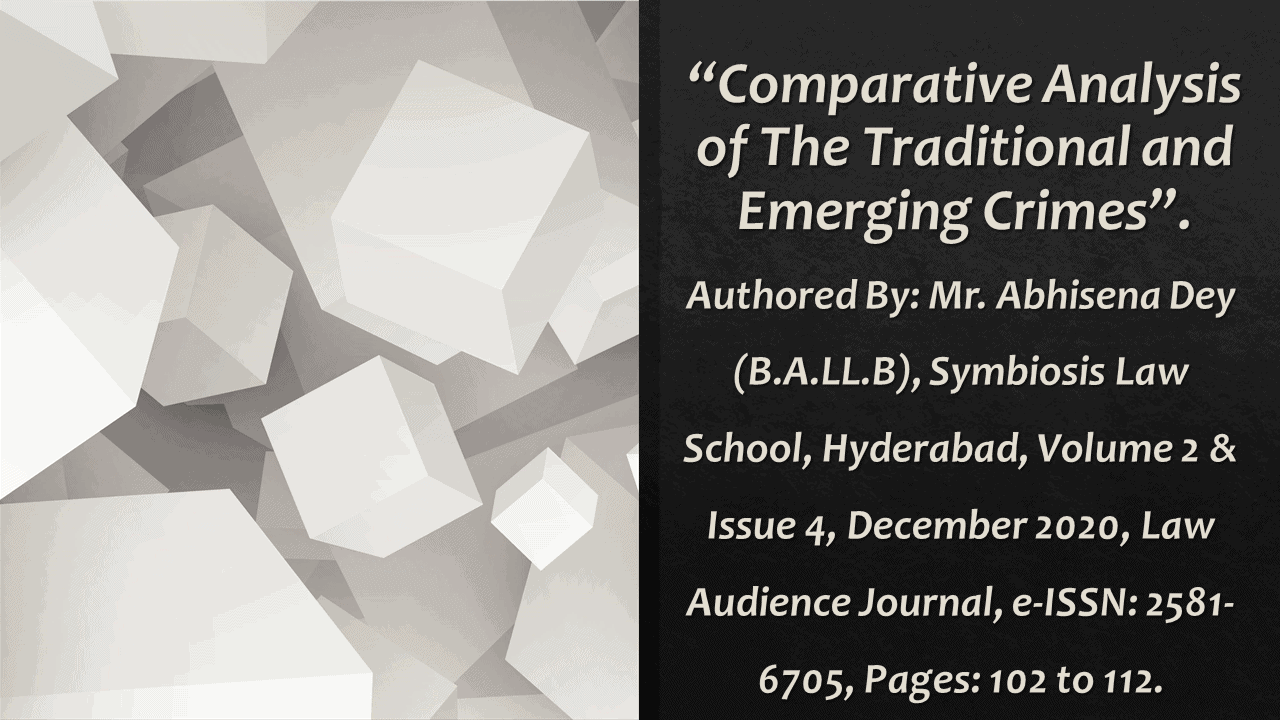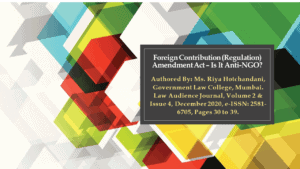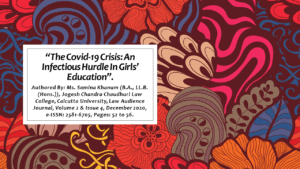Click here to download the full paper (PDF)
Authored By: Mr. Abhisena Dey (B.A.LL.B), Symbiosis Law School, Hyderabad.
Click here for Copyright Policy.
Click here for Disclaimer.
I. INTRODUCTION:
Edwin Hardin Sutherland, one of the most famous and dominant criminologists as well as sociologist of the 20th century, coined the phrase white-collar criminal in a speech to the American Sociological Association on December 27, 1939. In his 1949 monograph White-Collar Crime he defined a white-collar crime “approximately as a crime committed by a person of respectability and high social status in the course of his occupation.[1]” This definition has five features to it:
- It is a crime;
- An influential person of the company commits it;
- He has a high social standing;
- He has committed it during his occupation or profession;
- There can be breach of trust;
Emerging crimes, or white-collar crimes, are crimes without violence, which is connected with the corporate sector and are commonly committed by business persons and government officials. They are basically crimes which are committed by people who hold significant status in a company. Crimes committed by people of high social standing and having respect in society, within their profession, are termed white collar crimes. They enumerate illegal actions done by persons in the normal course of their occupation and covers embezzlement, bribery, fraud and extortion.
They are committed for obtaining financial benefits. They are committed by persons of respectable social standing in the course of their profession to obtain financial gains. White collar crimes have been largely affected by changes in the information technology, which have brought new layers into them. For example, internet and cybercrimes run rampant in today’s world. All these crimes are borne out of greed. Generally, those who carry out these crimes are financially well off. The expansion and spread of business and political affinities have added new dimensions to these emerging crimes like internet fraud, bribery, stock fraud, income tax evasions, work and safety violations, bank frauds, cellular phone frauds, blackmails, credit card frauds, insurance frauds, health care frauds etc.[2]
The word “blue collar crime” or traditional crime was coined in the 1920s. It signified Americans who did manual labor. These people wore clothes which were of a dark shade which served the purpose of hiding stains. Some of them wore clothes having a blue collar. They worked for very low income on hourly basis. Traditional crimes have been committed throughout the centuries and it is present in every business, profession and industry.
II. TYPES OF EMERGING CRIMES:
II.I Bank Fraud:
Fraud means a crime done with the aim to deceive someone and achieve undue advantage. Bank fraud, hence, means fraud which is committed on banks. Fraudulent companies carry it out through false representations. Bank fraud is also associated with manipulation of negotiable instruments such as bouncing of cheque, bank deposits, securities etc. It concerns the people due to the fact that the banks and the people have a trust relation between themselves. Bank fraud is considered to be the most common white-collar crime, alongside being a corporate one. It is detrimental to both the people and the government of a country. [3]
II.II Bribery:
Bribery is another ordinary type of white-collar crime. It connotes giving money or other goods to persons enjoying a high position or status to gain some favor. It means a person giving money to someone who has authority to grant him some favor. Bribery is committed with the intention of insisting a person to do or not to do something. In India, bribery accounts for the most common form of income of most of the public officials[4].
II.III Cybercrime:
Cybercrime is the largest facilitator resulting in emergence of white collar crimes in India. It accounts for the most profound problem present in the cyber world. It signifies crime which is concerned with computer networks. With fast developments in technology has come a phenomenal increase in crimes related to technology. Cybercrime are committed by people who have expertise in computer technology. Cybercrime is carried out directly or indirectly, to inflict harm to one’s reputation or to cause harm physically or mentally with help of internet, networks and various other technological sources. Cybercrime is a threat to the country as well as the personal security and financial status of people. It can lead to exponential financial loss for the country. Further, it is also a problem for a person’s privacy. It can lead to disclosure of confidential information, which can cause various types of privacy issues. Cybercrimes against women are also increasing. With the help of telecommunication networks, mobile phones, cyber criminals send offensive and obscene messages as well as pictures to women[5].
II.IV Money Laundering:
Money laundering means hiding the identity of money. The perpetrators of this crime conceal the original ownership of the money as well as the place from where they acquired it using illegal methods. Money Laundering is committed with the goal to make that illegally acquired money seemingly legal by making it appear to come from legal sources. Thus, it connotes the portraying of illegal money as legitimate money. For example, when a person acquires money from black market or trafficking of illegal goods, that money is illegitimate, meaning that he cannot deposit it in banks as it will create suspicion due to the fact that he will have to create statements and records showing from he acquired that money. Now, money laundering encompasses three steps[6]:
- The person acquires the money though illegal methods and deposit it in the bank somehow
- Then the money is transferred by way of multiple transactions
- Finally, the money is returned to the bank to make it seem legal
II.V Tax Evasion:
Tax evasion is carried out to hide one’s actual taxable income and original position to the tax authorities. This is done with the intention of lessening the tax liability in the government’s eyes. It basically means to conceal money acquired through illegitimate sources to reduce tax liability and to portray low income to the government. Tax evasion has tremendous negative impact on the nation. It demoralizes honest tax payers, by making them want to evade tax too as it places the bulk of the economic power in a limited number of undeserving people[7].
II.VI Identity Theft:
Owing to development in technology, it is a cakewalk to acquire anyone’s personal information. This makes identity theft a relatively easy crime nowadays. Identity theft means crime where the perpetrator gains access to unauthorized information like name, address and phone number to acquiring money. It is basically commission of fraud or acquiring of money through illegitimate methods by making use of the identity of another[8].
III. GROWTH AND BACKGROUND OF EMERGING CRIMES:
III.I Reasons for growth[9]:
III.I.I Greed:
It was the notion of Machiavelli, the father of modern political philosophy, that men are greedy by nature. He held that a man forgets the death of his father quicker and more easily than the loss of his inheritance. White collar crimes go by the same philosophy. It is basic human tendency to commit such crimes out of greed if someone is financially well off and enjoys high social standing and significance.[10]
III.I.II Easy, swift and prolong effect:
Developments in technology, expansion and diversification of business and political affinities have equipped people with new tools of commission of crimes. Technology, in particular, has made it far easier and quicker to cause harm to others. Further, the remedial methods of these crimes are more expensive and complicated than those of traditional crimes such as murder or robbery, thus taking it longer for the victim to recover. This has the effect of cutting down completion.[11]
III.I.III Competition:
The changing dynamics in the world and the introduction of strict laws and enforcement mechanisms for deterrence of traditional crimes, people have adapted to the changing ways. They have figured out smarter, more complicated and elaborate schemes to commit crime and gain financial benefits, in the form of white-collar crimes. This ties in with the phrase, “survival of the fittest”, by Darwin, wherein the one adapting to circumstances and situations survive.[12]
III.I.IV Lack of stringent laws:
Due to the fact that the emerging crimes are carried out through the internet and digital ways of payment transfers, the laws fail to control them as the investigation and tracking of these crimes are very challenging and complicated. The fact that these crimes are committed in private homes or offices with eyewitnesses makes catching the criminals that much more difficult.[13]
III.I.V Lack of awareness:
The victims of these crimes are, in most cases, unable to understand their loss or to locate it, as the nature of these crimes are much different than traditional ones, resulting in lack of awareness of them by people[14].
III.I.VI Necessity:
Sometimes, there are cases where people commit these crimes to make their and their family’s ends meet, but generally they are carried out by people of high social standing to feed their ego[15].
III.II Backgrounds:
The first documented case of white-collar crime was in 1473 in England, known as the Carrier’s case. In this case, the agent, who had the duty of the principal for the transportation of wool from one place to another, was found guilty of stealing wool. Following this case, the English court introduced the principle of “breaking the bulk”, which signifies that bailee who had the possession of goods tried to break it open and misappropriate the contents. The development of industrial capitalism has pushed crime to another level altogether. The bourgeois community goes on with these crimes due to greed and misery to acquire and own more and more. The Sherman Antitrust Act passed in 1890 in the US criminalized monopolistic practices. The punishments imposed on white collar crimes in England and the introduction of antitrust and competition laws in other countries did not have the same effect as the Sherman Act. A group of journalists, in the last 18th and early 19th century, leaded the common people to revolts for reforms. The Congress made enormous efforts in 1914 to improve the sentiments introduced by the Sherman Act. The resulting reforms were stricter compared to the Sherman Act in the deterrence of monopolistic practices[16].
IV. FUNDAMENTAL DIFFERENCES BETWEEN TRADITIONAL AND EMERGING CRIMES:
Traditional crime involves a certain general category of crimes and it lack any official legal classification. They refer to those crimes which are carried out for immediate and short-term gains to the person or group committing it. They also encompass crimes personal crimes which are carried out due to immediate reaction, as in fights or heated arguments. The word “blue collar crimes” was coined to signify crimes committed by people from the lower or working class. Generally, these crimes are facilitated by rage, passion and other emotions, unlike emerging white-collar ones, which are properly planned and considered. Traditional crimes include those which inflict harm to people or property, like murder, assault, sex crimes, theft, burglary, property crimes, breaking and entering and crimes associated with drugs. These crimes are generally of a small scale compared to white collar crimes. Traditional crimes do only include low-income workers, but also the unemployed, who generally belong to the lower strata of society. Owing to the nature of their work, blue-collar workers do not have the opportunity to carry out crimes inside an organization or company, like embezzlement, fraud or money laundering. The latter crimes pre necessitate a certain position and influence inside a company and can thus be performed only people of high social standing and power. Though, this is not to suggest that white-collar workers never commit traditional crimes. It is just that the emerging white-collar crimes have an innate connection with the values and general trend or culture of society. The most visible proof of this is the fact that people who commit white collar crimes are smart, stable and successful in their fields and belong to the higher strata of society, unlike common criminals.[17]
Thus, the main difference between traditional and emerging crimes is that the perpetrators of the former belong to the underprivileged classes, and those of the later belong to the upper classes of society, who carry out crimes in a planned and carefully considered manner. People involved with the emerging crimes are smart, cunning and generally successful persons, unlike ordinary criminals. It is relatively difficult and complicated to track white collar crimes, unlike traditional crimes which are very direct and personal and include violence. The traditional criminals are generally careful of the law enforcement authorities due to that fact that they will be fined or put into imprisonment a lot more easily and without much hassle if detected, unlike white collar criminals. The emerging crimes are generally borne out of greed and to feed own ego, and is carefully organized and considered. The traditional blue-collar crimes, however, are mainly done out of revenge, anger, or other forms of emotion or personal issues. White collar crimes mostly bring damage to money, but blue-collar crimes cause bodily or mental harm. The Apex Court in the case of State of Gujarat v. Mohanlal Jitamalji Porwal and Another[18], laid down the contrast between traditional or blue-collar crimes and emerging or white-collar crimes. In that case, Thakker J. observed that murder can be caused in the heat of the moment, however, inflicting financial harm or carrying out financial offences like embezzlement or money laundering necessitate care organization. It needs strategizing and careful consideration and planning to acquire profits.
The fundamental differences between traditional and emerging crimes can be jotted down in the following main points;
IV.I Meaning:
Traditional crimes involve persons who are commit crimes physically. Emerging crimes require knowledge and the criminals utilize their expertise and knowledge to carry out crimes[19].
IV.II New v. Traditional:
Traditional crimes have been prevalent throughout the centuries, while white collar crimes have recently come up and are a new type of crimes[20].
IV.III Mens Rea:
Crime necessitates the presence of both mens rea and actus reus. Mens rea is an important component in traditional crimes, whereas in emerging crimes it is not required. The theory is that though it is proved that no mens rea was present in white collar crimes, it has to be penalized to send a message to the criminals that the society is now much aware of their crimes and strict laws will be implemented to deter the same. It is sometimes true that only a constructive element of mens rea is considered by the Judiciary in the trial of white-collar offenders. The Indian legal reforms had taken steps such as penalizing just dishonoring of negotiable instruments without considering the mens rea in it.[21]
IV.IV Independent of social and personal conditions:
Social dynamics such as poverty or unemployment are important facilitators in traditional crimes, whereas they are not a factor in white collar crimes[22].
IV.V Direct Access to Targets:
Due to the fact that the perpetrators of white-collar crimes enjoy an influential position in an organization, they have easy and direct access to their targets. However, it is not so in the case of traditional crimes. For instance, if one is to commit theft in another’s house, he has to either break in the house or use some other cunning way to gain access to the house, all of which are relatively difficult. Whereas in the case of white-collar crimes, the person has direct access to their target through his influence and higher status.
IV.VI Veiled Offenders:
In the case of traditional crimes, the perpetrator has to come face to face to cause harm and to commit the crime. However, in emerging crimes, one is not required to do so and thus, their identity remains concealed.
IV.VII Involvement of Politicians:
It is often seen that the perpetrators of crime have influential connections with politicians, who in turn are sometimes involved in the crime. This makes the harder for the victims to report the offenders[23].
IV.VIII Greater Harm:
The damage caused by white collar crimes are relatively difficult to bear than the harm caused by traditional crimes. Further, the damage inflicted by emerging crimes would affect not only common people, but also other organizations and institutions and even the government. If the financial harm suffered by the nations’ economy is considered, we would see that the country suffers much more from the emerging crimes than all of the traditional crimes combined. It is argued that the cost of tackling and coping with white collar crime covers the cost of dealing with all of the traditional crimes taking place in the nation during the same time. For instance, the share scam of 1992 committed by Harshad Mehta was so severe and the people who suffered due to it are so large in number, that it was impossible to identify all of them[24].
IV.IX Victim Awareness:
The victim is instantly found in case of traditional crimes and he is aware that he has suffered a crime, unlike in emerging crimes. People are not generally aware of the cause of a sudden market crash or the sudden closing down of a company. The effect of white-collar crimes is indirect which means that the victim does not understand the significance of the news or the loss caused to him due to it. There is a distinction in how white-collar crimes, associated by people of higher status, and traditional crimes, which are committed by people of lower rungs of society, are investigated and prosecuted. Differences present in public opinion has a major impact in the distinction between how both types of crimes are investigated as the media gets involved and the attention that society gives to the crime.
It is often the case that crimes which involve violence like murder are prioritized by the media and this leads to heightened reaction from the public when compared to organized white-collar crimes. This is the reason why the people sometimes have an imbalanced perception of traditional crime and think of white-collar crimes as relatively rare and not that much affecting in their lives. Further, the people find it easier to gauge traditional crime. Emerging crimes are more complicated and difficult to track or understand, both for the common people as well as the investigating authorities. Even the victims of the latter more often than not have do not understand the crime and the impact of the harm caused by it.[25]
Perpetrators of emerging crimes also have an edge due to their influence, wealth and contacts. White collar criminals benefit from “institutionalized non-enforcement practices, regulatory policies and legal representation not available” to traditional criminals. Because of this, those who commit white collar crimes are very difficult to track and prosecute, though they cause a serious amount of damage to society.
V. CONCLUSION:
Two important features are present in the new and emerging crimes. Firstly, they are without violence, although the people who commit them often try to achieve control or some entitlement. Secondly, they are usually committed by people belonging to respectable and sophisticated professions.
It is, although true, that they are also committed by people who are poorly paid, though the brains behind those crimes are generally wealthy and affluent people having a high social standing. White collar crimes are also sometimes committed by people due to peer pressure or are based on the company’s culture.
The rate of these crimes is increasing rapidly, with the advancement of our society and with developments in technological fields. Ranging from educational spheres to medical profession, white collar crimes are carried out in every field nowadays. Added to this is the increase in instances of online frauds. Developing countries, like India, have had to face various challenges to develop and grow their economies, owing to these crimes and added corruption.
It is the need of the hour to provide training to the investigation personnel, to track the perpetrators of these crimes, as they very difficult and complicated to catch. Further, work of the investigating personnel needs to be carefully followed up as the emerging crimes are carried out by people having high social standing in their profession.
[1] Edwin Sutherland, available at https://en.wikipedia.org/wiki/Edwin_Sutherland#:~:text=In%20his%201949%20monograph%20White,the%20course%20of%20his%20occupation.%22.
[2] https://www.researchgate.net/publication/228274284_T he_Concept_of_White_Collar_Crime_in_Law_and_Le gal_Theory.
[3] “Criminal Liability of corporate bodies” by Vikas Garg.
[4] Ibid.
[5] Ibid.
[6] Ibid.
[7] Ibid.
[8] Ibid.
[9] Aayushi Swaroop (National University of Study and Research in Law, Ranchi), White Collar Crimes in India, available at https://blog.ipleaders.in/white-collar-crimes/.
[10] Ibid.
[11] Ibid.
[12] Ibid.
[13] Ibid.
[14] Ibid.
[15] Ibid.
[16] Ibid.
[17] Sutherland, “Is ‘White Collar Crime’ Crime,”.
[18] 1987 AIR 1321, 1987 SCR (2)
[19] supra note 9
[20] Ibid.
[21] Ibid.
[22] Ibid.
[23] Ibid.
[24] Ibid.
[25] “White Collar Crime Survey” by Indian National Bar Association.



